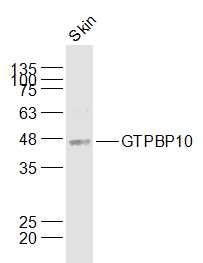GTP-binding protein 10 (GTPBP10) belongs to the GTP1/OBG family. Small G proteins, such as GTPBP10, act as molecular switches that play crucial roles in the regulation of fundamental cellular processes such as protein synthesis, nuclear transport, membrane trafficking, and signal transduction; GTPBA_HUMAN; GTP-binding protein 10; Protein obg homolog 2; ObgH2.
Function:
May be involved in the ribosome maturation process. Complements an ObgE(CgtA) function in E.coli ribosome maturation. Plays a role of GTPase in vitro. When missing, disorganization of the nuceleolar architecture is observed.
Subcellular Location:
Nucleus, nucleolus. Chromosome. Note=Found in the dense fibrillar compartment region of the nucleolus. At the onset of mitosis moves to the chromosome surface and remains there until anaphase. Gradually re-assembles into the nucleolus at late anaphase to telophase.
Similarity:
Belongs to the GTP1/OBG family.
SWISS:
A4D1E9
Gene ID:
85865
Database links:
Entrez Gene: 85865 Human
Entrez Gene: 207704 Mouse
Omim: 610920 Human
SwissProt: A4D1E9 Human
SwissProt: Q8K013 Mouse
Unigene: 593547 Human
Unigene: 709271 Human
Unigene: 323984 Mouse
| Picture |
Sample:
Skin (Mouse) Lysate at 40 ug
Primary: Anti-GTPBP10 (SL3893R) at 1/1000 dilution
Secondary: IRDye800CW Goat Anti-Rabbit IgG at 1/20000 dilution
Predicted band size: 43 kD
Observed band size: 45 kD
Tissue/cell: rat brain tissue; 4% Paraformaldehyde-fixed and paraffin-embedded;
Antigen retrieval: citrate buffer ( 0.01M, pH 6.0 ), Boiling bathing for 15min; Block endogenous peroxidase by 3% Hydrogen peroxide for 30min; Blocking buffer (normal goat serum,SLC0005) at 37℃ for 20 min;
Incubation: Anti-GTPBP10 Polyclonal Antibody, Unconjugated(SL3893R) 1:200, overnight at 4°C, followed by conjugation to the secondary antibody(SP-0023) and DAB(SLC0010) staining
|
|
|

